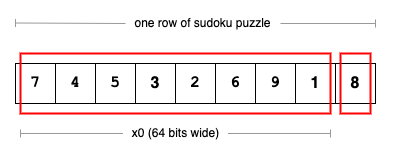LeetCode Is Leet
 There is a “leetcode challenge” on the net that reads: implement
There is a “leetcode challenge” on the net that reads: implement
is-sudoku-valid in assembly language. I watched Primeagen mess around
live on-stream, and being a bit of a sudoku-nut myself, I figured I would
take a stab at it, too. My personal spin: using arm64 assembly.
And so I saved a raspberry pi 4 from a drawer and booted up.
The raspberry pi 4 is a neat little computer that is capable of running a 64-bit operating system. It’s not the fastest system, and its I/O is particularly slow, but the neat part is, we get to code in arm64 assembly for Linux. We need to get a few things straigthened out before we can actually dive into the code.
ARM64 code is different from ARM32 code. Any examples on the internets mentioning “register R0” are no good; aarch64 is a different architecture, and therefore also has a different assembly language. It also comes with its own conventions that we should adhere to.
- register
x0-x8are used as function input parameters and return values - register
x9-x15are scratch registers - register
x16-x17are “intra-procedure-call” scratch registers x18is reserved to point at some operating system dependent tablex19-x28are “non-volatile” registersx29is the frame pointer. You should let it point at the current stack of the current function; this aids debuggingx30is the link register. It holds the return address of the subroutine, but note that you must save it on the stack if you call a deeper subroutine
For the unwary, the above means that any subroutine may clobber
registers x0-x15 at any time. If you need to preserve their values,
use x19-x28 instead. A subroutine that needs to use x19-x28
for something else, should save the register on the stack and
restore it before returning.
Registers x16, x17 may be used across subroutines, but you should take
care that they stay valid and correct for all code paths.
You may wonder why there is no register x31. The instruction encoding
uses number 31 for either the stack pointer or the special zero register
xzr, a read-only register that always reads zero.
Just another ARM trick: copying (zero) from a register is much faster
than loading a zero value from memory.
The x-registers are 64 bits wide. Use w0-w30 to address the lower 32 bits
of the register. Doing so automatically zero-extends the upper 32 bits
of the register. There are instructions that deal with loading and storing
individual bytes, but on ARM you can’t address the lower byte of a register
like you would on x86.
Eight arms to hold you
For the sudoku challenge we will be loading bytes (sudoku digits) into 64-bits wide registers. A sudoku row has nine numbers. For checking the validity of a row, we can load 8 bytes at once (64 bits), and then load the remaining byte.
/* x1 := address of sudoku puzzle, first row */
ldr x1, =sudoku
/*
load 8 digits into x0
afterwards x1 points at digit 9
*/
ldr x0, [x1], #8
/* ... and later on ... */
/*
load 9th digit into x0
*/
ldrb w0, [x1], #1
A row is valid when all digits 1 to 9 are present, each used exactly once. What we can do is keep a table, or … we can set a bit for each digit that is present. If all digits are present, then we should end up with having nine bits set.
So, we have 8 digits in x0. We want to take one digit (one byte) from it,
and then set a bit for it in another register—I’ll pick x6 for this
(because, why not).
We can calculate the bit number by shifting the value 1 to the left.
In pseudo-code:
nine_bits = 0
digit = (byte)(x0 & 0xff)
bit = (1 << digit)
nine_bits |= bit
This can easily be translated to assembly language. The only thing is,
in assembly language you can’t have an immediate value at the lefthand side
of a shift operation. So we use a register (x4) to hold the value 1.
/* nine_bits are clear */
mov x6, xzr
/* x2 := digit = (byte)(x0 & 0xff) */
and x2, x0, #0xff
/* x2 := bit = (1 << digit) */
mov x4, #1
lsl x2, x4, x2
/* x6 := nine_bits |= bit */
orr x6, x6, x2
Now loop eight times to gather all bits. To get the next digit from x0,
we must “shift out” the byte we just processed.
/* x0 := x0 >> 8 */
lsr x0, x0, #8
After looping eight times (not shown here) we have processed eight numbers
of the sudoku puzzle. The nineth number in the row is added as a separate
step. Next, we check whether x6 has all nine bits set.
But wait, what happens if the row contains the number 7 twice? Then bit #7 will be (doubly) set, but some other bit will be missing. The only way the row can be correct, is to end up with nine bits set.
Also, mind that sudoku uses numbers 1 to 9, and therefore bit zero
remains unset.
/*
if not all nine bits set,
then it's an invalid row
*/
cmp x6, 0b01111111110
bne invalid_row
If we fell through, the row is valid! Loop nine times to check all rows (not shown here).
A little bit more
Above we are loading eight numbers at a time into a register. The sudoku row is 9 numbers long, so we fell one short. It is possible to encode a digit in just 4 bits (a nibble) … making it possible to fit 16 digits into a single register. So we can make it load an entire row at once, if we really want to.
Encoding the sudoku in nibbles does not make life easier for checking the rest of the puzzle though, so I will leave it at that.
However! There is another clever trick that we can do. Checking columns makes us jump through memory, and checking blocks is a tedious bit of code. But what we can do is change the memory layout of columns and blocks; they are again a group of nine numbers, if we transpose them to a horizontal layout in memory, then we can use the same subroutine for checking rows, columns, and blocks. (Bonus points, I guess).
Sudoku make me a sandwich
Checking a sudoku puzzle for validity is not a super difficult programming problem. The key is to break the problem down into smaller parts, and this is especially true for programming in assembly language.
A sudoku puzzle is solved when:
- each row contains exactly the numbers 1 to 9
- each column contains exactly the numbers 1 to 9
- each 3x3 block in the grid contains exactly the numbers 1 to 9
So, in code (be it assembly or not) these three rules can be written as:
check_rows
check_columns
check_blocks
Now, let’s break it down further:
check_rows:
check_row i
loop 9 times
check_columns:
check_column j
loop 9 times
check_blocks:
check_block k
loop 9 times
Keep breaking it down, and the assembly code basically writes itself. So much so, I wrote multiple implementations. Find the full codes on github.
